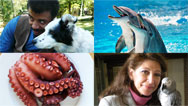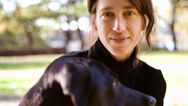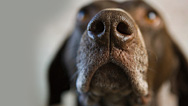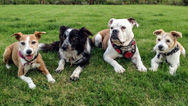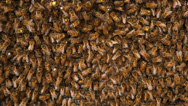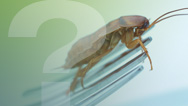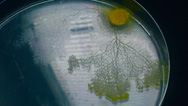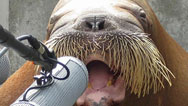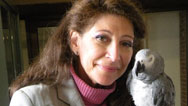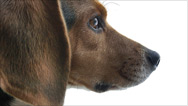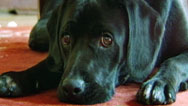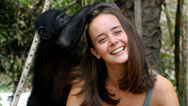
What Are Animals Thinking?
Probe animal morality, the "swarm intelligence" of a beehive, the amazing navigation talents of pigeons, and more. Airing November 7, 2012 at 9 pm on PBS Aired November 7, 2012 on PBS
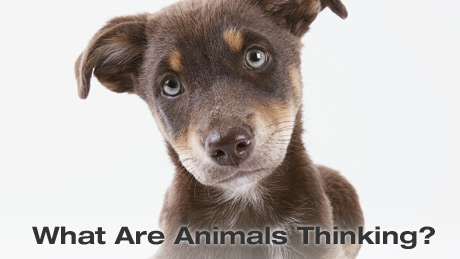
Program Description
Transcript
What Are Animals Thinking?
PBS Airdate: November 7, 2012
DAVID POGUE: Have you ever wondered what animals are thinking.
Show me the love.
I'm David Pogue, and on this episode of NOVA scienceNOW, we're exploring the mysteries of the animal mind.
Like, what's really behind your dog's guilty look.
FINN'S OWNER: No, bad.
DAVID POGUE: Is it possible that a rat knows right from wrong.
They're not smart enough to share. They're rats.
PEGGY MASON (University of Chicago): They're nice, they share.
BRIAN HARE (Duke University): People would have probably predicted that this is something that only humans do.
DAVID POGUE: Oh! Come on.
What secrets lie in this bird's brain.
Hey! There's a pigeon back here.
CHARLES WALCOTT (Cornell University): How do pigeons find their way home? That is the fundamental mystery.
DAVID POGUE: My hunt for animal intelligence leads in strange directions.
ANNE PRINGLE (Harvard University): That is a wild slime mold.
DAVID POGUE: There is no way this thing is intelligent.
ANNE PRINGLE: I think you might be surprised.
DAVID POGUE: Could a hive of bees actually function like the human brain.
Dude! You're sticking your finger in there.
IAIN COUZIN (Princeton University): This completely blows away this idea that you have to be really smart to solve problems.
DAVID POGUE: Stay tuned, as I'm trapped, kidnapped,….
There's no seats in this van.
JIM KORINECK (Pigeon Owner): That's right.
DAVID POGUE: …and thrown to the bees,….
Where's my bee suit.
…all to find out What Are Animals Thinking? Up next, on Nova scienceNOW.
We humans sure love our animals.
She has nail polish on.
And many of us are eager to believe that inside their little heads, they're a lot like us.
BEBE'S OWNER: Any kind of feelings that I can feel, I believe that Bebe is able to feel also.
DOG OWNER ONE: They have a heart, they have a soul, and they definitely can feel what humans do.
DAVID POGUE: And plenty of pet owners are convinced that those feelings include a sense of morality.
Do you think she knows right from wrong.
DOG OWNER TWO: I definitely think she knows right from wrong.
BOCKER'S OWNER: I think Bocker knows right from wrong. He definitely does.
DOG OWNER THREE: I definitely do think they know right from wrong.
DAVID POGUE: Scientists are generally much more skeptical than pet owners. But recently, researchers have started taking this question seriously, and a slew of new studies on different kinds of creatures has been tackling the question, "Do animals have morals?.
The results might surprise you.
First up, one of the most popular pieces of evidence offered up by pet owners.
DOG OWNER FOUR: I think she can understand right from wrong, because if she did something wrong, she has that guilty look on her face.
DAVID POGUE: Ah, yes, the guilty look.
DENVER'S OWNER: Denver! Did you do this? You got into the kitty cat's treats.
DAVID POGUE: This video has been seen over 20 million times on YouTube.
DENVER'S OWNER: Are you sorry about it.
DAVID POGUE: But what is Denver really thinking? Does that pitiful look on her face really mean that she actually feels guilty.
ALEXANDRA HOROWITZ (Barnard College, Columbia University): It's really effective, I mean, it's a cute look. It's a definite real look.
DAVID POGUE: Scientists like Alexandra Horowitz, who runs the Dog Cognition Lab at Barnard College, Columbia University, are skeptical. Horowitz wanted to know what the famous "guilty look" really meant.
ALEXANDRA HOROWITZ: Does the guilty look in dogs mean that they're actually guilty? And it's all about whether dogs have an understanding of right or wrong.
DAVID POGUE: To try to find out, she devised a clever, and, I have to say, pretty sneaky, experiment.
ALEXANDRA HOROWITZ: Put it by your toes.
DAVID POGUE: First, she has the dog's owner place a treat on the floor and tell the dog not to eat it.
CODY'S OWNER: Stay. Leave it.
DAVID POGUE: Then she has the owner leave the room. With the owner safely out of sight, Horowitz has me grab the treat and then lie to the owner.
Okay, you can come in. He ate it.
CODY'S OWNER: You ate it? I told you not to eat it.
DAVID POGUE: Forget the dog, I feel guilty.
CODY'S OWNER: Cody! I told you not to eat it.
DAVID POGUE: Even though Cody has done nothing wrong, there's that look.
CODY'S OWNER: Can you look at me? Yeah you don't want to.
ALEXANDRA HOROWITZ: You really have to direct her not to eat it.
DAVID POGUE: Horowitz repeated this experiment with other dogs and their owners.
DOG OWNER FIVE: Bad.
DAVID POGUE: And the results were clear.
DOG OWNER SIX: No.
ALEXANDRA HOROWITZ: "Here's the face I have to give when somebody's yelling at me." And does this indicate that that dog felt that he was guilty.
FINN'S OWNER: Finn! No.
ALEXANDRA HOROWITZ: No, it doesn't. It indicates that that dog knows how to react to that owner.
DAVID POGUE: In other words, these dogs aren't fessing up to anything. They're just reacting to a scolding.
You make it sound like we're sort of being played.
ALEXANDRA HOROWITZ: Well they're learning what works with us.
DOG OWNER SEVEN: No, bad boy.
DAVID POGUE: Does that mean that dogs can't know the difference between right and wrong.
ALEXANDRA HOROWITZ: I think it doesn't make any sense to pretend that they understand our moral terms. And I think it's really important to mark a difference between a dog's moral sense and our moral sense and realize they're not working on our terms.
DAVID POGUE: So in this case, even though we might be projecting our values onto our dogs, that doesn't mean that they can't have their own moral sense.
Hey, good girl.
In fact, in the last decade, a growing number of new studies are showing us that many animals, not just dogs, do seem to have a capacity for rudimentary moral behavior, to feel empathy and help each other out in ways we used to think were uniquely human. And, in the process, they're giving us new insights into the roots of our own morality.
BRIAN HARE: Why are humans moral? What is morality? Where does it come from? Well, we go study animals, and they can tell us a lot about the answer to that question.
DAVID POGUE: Friederike Range would agree. She's testing dogs, here at the University of Vienna, in Austria, and suspects humans aren't the only species with a sense of fairness.
FRIEDERIKE RANGE (University of Vienna): Hi.
DAVID POGUE: I'm David.
FRIEDERIKE RANGE: Friederike. Nice to meet you.
DAVID POGUE: Nice to meet you.
FRIEDERIKE RANGE: This is Guinness.
DAVID POGUE: Range is about to teach me how to conduct a simple experiment to test whether dogs have a sense of fairness.
Paw.
At first, I just ask Guinness for her paw….
Paw.
…and give her nothing in return.
Paw. Paw. Paw. Paw. Paw.
We do it 30 times, without a problem.
Paw.
That a girl.
Then Range brings in Guinness's pal, Toddy.
Paw.
Now I ask both to give me their paws. But, when Toddy does it, I give him a tasty treat.
Just as before, Guinness gets nothing.
Paw.
Paw. To the good little boy….
And Paw.
At first, Guinness keeps it up, but after seeing Toddy get rewarded for doing the same thing, she starts to whimper and then goes on strike.
Paw.
Range has done the same experiment with dozens of dogs and seen exactly the same result. She believes it's evidence that dogs know when they're being wronged.
If you could write a script for the sorts of things that they're thinking, what would it be.
FRIEDERIKE RANGE: One possibility is, yes, "It isn't fair. He's getting food, and I don't. Why should I work for free while he's getting rewarded?" It's really difficult to avoid the word "fairness..
DAVID POGUE: Other experiments—with ravens, elephants, chimps and monkeys—are suggesting that we may share moral traits, like fairness, with other species.
BRIAN HARE: What's really exciting about these studies is this is sort of the first evidence that animals may have a rudimentary, simple form of fairness that then, maybe, through evolutionary time, has then been built upon and has become more complex in our own species.
DAVID POGUE: So it's one thing to know when you're being treated unfairly, but what about apparently selfless acts, like sharing with complete strangers.
This is Vienna sausage.
FRIEDERIKE RANGE: Yeah. You can have a piece.
BRIAN HARE: People, including myself, would've probably predicted that this is something that only humans do.
DAVID POGUE: That's what Brian Hare, a primatologist at Duke University, used to think, until one day, when he got a call from his student, Suzy Kwetuenda, in the Congo, saying she thought bonobos, a type of great ape, might actually share.
BRIAN HARE: I was like, "Oh, come on, Suzy, there's no way." And she was really insistent. So I said, "Okay, well, let's do an experiment..
DAVID POGUE: So Hare and Kwetuenda set up a special situation for two bonobos. One, the stranger, was locked in a room with a key that could be turned only from the other side.
SUZY KWETUENDA: Sake! Sake, Eleke.
DAVID POGUE: The other, in this case, Sake, was free to wander around.
Then Kwetuenda places a pile of fruit pieces outside the locked room. Sake has a choice: she can eat all the food herself or open the door to release the strange bonobo she's never met and possibly give up some of her food.
BRIAN HARE: Think about it. You see somebody at the table next to you with no food, are you going to go up to the person that you don't know and say, "Hey, would you like to eat half of the food I just ordered?" You know, how many times have any of us done that.
DAVID POGUE: Will Sake open the door for the stranger and share the food.
BRIAN HARE: It's the closest thing that you can think of to doing charity in animals.
DAVID POGUE: So humans might not be the only ones capable of kindness to strangers. But what was Sake thinking? Did she feel sorry for the other bonobo? Was she feeling empathy.
BRIAN HARE: I can't really tell that. All I can tell you is that Sake didn't have to do that. Sake could have just eaten the food. It may be that bonobos just really enjoy eating together; it may not be empathy, in this case.
DAVID POGUE: Empathy. It's considered a uniquely human trait, explained here in the classic Funny Face.
FRED ASTAIRE (In Funny Face, 1957): …something like sympathy.
AUDREY HEPBURN (In Funny Face, 1957): Oh, it goes beyond sympathy. Sympathy is to understand what someone feels. Empathy is to project your imagination so that you actually feel what the other person is feeling.
DAVID POGUE: And to demonstrate that uniquely human trait, I've come here to Times Square to test it out for myself on the world's toughest crowd.
Let me out.
My kindly producers have shut me into a Plexiglas box that can be unlocked only from the outside. I'm totally helpless. Will my fellow human beings sense my distress and help me out.
Sure enough, after a few weird looks, my species comes through….
Thank you so much.
… over and over again.
Thank you! Thank you.
Would an animal ever do this.
The answer might come from the last creature you'd think to ask: rats.
At the University of Chicago, neuroscientist Peggy Mason is about to show me that empathy might not be just for humans.
PEGGY MASON: Are you going to be empathic today? Yeah.
DAVID POGUE: To test her idea, she's built a special predicament for two rats: one is trapped inside a Plexiglas tube, with a door that can be opened only from the outside. The other is free to run around, and he's never been taught how to open that door.
So you think that Free Rat is literally trying to set free Trapped Rat out of pure human concern.
PEGGY MASON: Or rat concern, as the case may be.
DAVID POGUE: Unbelievable. Look at that! He's trying to figure it out. What the heck.
Oh, my gosh.
And when they see their pal struggling, they certainly seem to work pretty darn hard to get their buddy out.
PEGGY MASON: He is pulling him out.
DAVID POGUE: Come on! He's like, "For crying out loud, I got you out, now bust out of here!.
Mason has run hundreds of rats through these set ups, and she's convinced it's the strongest experimental evidence, to date, of animal empathy.
PEGGY MASON: So, it's the first experiment where there's an action that is motivated by empathy. They're using empathic concern to actually help the other rat.
DAVID POGUE: So just how much do these rats really care? Mason wanted to find out, so she did a second experiment to give these rats a moral dilemma.
PEGGY MASON: What we did was we put two restrainers in the arena. And in one restrainer was the cage mate, and in the other restrainer was five chocolate chips. And these are rats that were eating, on average, seven chocolate chips in a sitting, so five chocolate chips, no problem.
DAVID POGUE: What will the free rat do? Will he hog all the chocolate to himself? Free the friend.
So, in theory, we've given Free Rat a choice.
PEGGY MASON: That's right.
DAVID POGUE: He can either let his pal out of the tube or go get a nice tasty snack. Hmm, checking out his pal. Oh, come on! He let the guy out first. Incredible.
Whoever gets there first is going to gobble it all up.
PEGGY MASON: Will they? Or will they share.
DAVID POGUE: They not smart enough to share. They're rats.
PEGGY MASON: They're nice, they share. So, on average, the free guy only eats three and half chocolates. There's five chocolates, so he's leaving one and half chocolates.
DAVID POGUE: I might have to think twice the next time I want to call someone a rat.
PEGGY MASON: Our study tells us a lot more about humans than it does about rats.
DAVID POGUE: Come on you guys! Somebody.
PEGGY MASON: And what I think it tells us about humans is that we are biologically mandated to be empathically concerned and helping.
BRIAN HARE: The more we're studying animals, what we're seeing is pieces of the moral system that we see in our own species. Now, no species has the whole package, but it basically tells us that our psychology, our brain, it didn't just appear out of thin air. It's actually built on something.
DAVID POGUE: Hello, New Yorkers. What am I, an animal.
Yeah, I am, and as long as my species treats me like one, it seems like I'll be just fine.
Oh, my gosh. Thank you very much! Elvis, ladies and gentleman.
Which animals will rescue others in need?
"Help me!"
Ants!
In one study, ants were tied up with nylon thread.
Other ants worked hard to free them…
…biting through the snares.
But…
only if they were related to the victims.
Ant altruisim…
…it's all in the family.
DAVID POGUE: As my mission continues into the minds of animals, I am about to come face to face with one of the biggest mysteries in animal research.
But first I have to go through security.
JOHN HAGSTRUM: (As Referee) I've been sent here to take all your electronic devices away from you.
DAVID POGUE: Dude, I am my electronic devices. For some reason, these guys don't trust me.
That's it. That's all I've got, dude.
JOHN HAGSTRUM: Oh, ho, well, what's this here.
DAVID POGUE: All right, well, for emergencies.
JOHN HAGSTRUM: Ah, ha. All right.
DAVID POGUE: There's no seats in this van, and there's no windows.
JOHN HAGSTRUM: That's right.
DAVID POGUE: As I am about to discover, all this cloak and dagger action is an effort to level the playing field, so I can compete against one of the animal kingdom's most amazing creatures.
Hey, there's a pigeon back here.
My fellow hostage is a Columba livia, more commonly known as a homing pigeon. She may not look extraordinary, but trust me, she is. And she's got a huge secret.
If you transport pigeons away from their home lofts and release them, they will immediately fly home.
Flying at close to 60 miles an hour, these pigeons consistently complete journeys up to a thousand miles long. That's farther than the distance from St. Louis to New York.
But how do they navigate so efficiently over completely unfamiliar terrain.
CHARLIE WALCOTT: Here is a question: How do pigeons find their way home? Been worked on for many, many years, and yet, it still is a mystery.
JOHN HAGSTRUM: We're here.
DAVID POGUE: Oh, my gosh. Where the hell are we.
JOHN HAGSTRUM: Dave, it's time to explain the rules.
DAVID POGUE: Yeah. I'd love to know what's going on.
And now I'm getting a real taste of the mystery, because this guy, pigeon owner Jim Korineck, is releasing the bird and me in a completely unknown location.
JIM KORINECK: So this is Zipline.
DAVID POGUE: Hello, Zipline.
JIM KORINECK: You're going to be racing a homing pigeon.
DAVID POGUE: The race will cover 60 miles, and the finish line is Zipline's home loft, in Tempe.
JIM KORINECK: Now, we're going to give you all sorts of help.
DAVID POGUE: Oh, you are.
JIM KORINECK: You get a compass.
Yes. And then a set of keys to a car.
Are you ready Zipline.
Go.
JIM KORINECK: If you can get in the car fast enough you can follow her.
DAVID POGUE: Wait.
I don't even know which way to start. Which, which road….
JIM KORINECK: Zipline's done this a lot of times. David doesn't have a chance.
DAVID POGUE: Oh, no. No, no, no, no, no.
At least I still I have my compass. I know that this way is north and this way is south, but wait a second, which way do I go.
I don't know what to do with this thing.
CHARLIE WALCOTT: One would think that a compass might be sufficient, and it isn't, for a very fundamental reason, which is that the compass tells you where north, south, east and west is, but it does not tell you where home is.
DAVID POGUE: All I know is that I'm somewhere in a 60 mile radius of Tempe, Arizona. Before I can figure out which direction to drive, I would first need to know where I am in relation to Tempe.
Since I've never been here before, even if I could find a road sign or a big landmark, I'd need to locate that on a map and then figure out the direction to Tempe.
Scientists know that, just like us, pigeons must navigate using both a compass and a map.
Recent studies show that pigeons can sense the earth's magnetic field and probably use that for their compass.
CHARLIE WALCOTT: The thing that we don't understand is what we call the map: how a pigeon, taken to some place where it's never been before and released, knows where it is with relation to home. That is the fundamental mystery.
DAVID POGUE: The mystery for me is where in the world am I.
Excuse me. Do you know how I can get to Tempe, Arizona.
CHARLIE WALCOTT: I have no idea how to get to Tempe, Arizona. But I'd love a ride.
DAVID POGUE: All right, hop in.
Full disclosure, this hitchhiker is actually a plant. You've met him before. He's Charles Walcott, professor of neurobiology at Cornell and world-renowned pigeon expert.
So I understand you know something about these homing pigeons.
CHARLIE WALCOTT: I've worked with them for 30 years.
DAVID POGUE: That probably gives you qualifications to answer this one tiny question that I've got: how do they do it.
CHARLIE WALCOTT: We don't know.
DAVID POGUE: Well, a lot of help you are.
CHARLIE WALCOTT: One theory is that the pigeons use odors, or smell to find their way home.
DAVID POGUE: It may sound a bit crazy, but scientists in Italy discovered that if you deprive a pigeon of its sense of smell, it won't make it home.
ANNA GAGLIARDO (University of Pisa): I think that pigeons use smell to navigate.
DAVID POGUE: Professor Anne Gagliardo believes that, from a young age, pigeons get their sense of direction from the odors around their home lofts.
ANNA GAGLIARDO: When the pigeons are at their home loft, they learn to associate the odors carried by the wind with the wind direction. And so they build up a sort of map of the environment.
DAVID POGUE: For example, imagine a pigeon knows that in its home loft, the smell of lemon comes from 10 degrees north and the smell of the sea comes from 100 degrees to the east. When they are taken to a release site, they will search for the smell of lemon and the scent of the sea to get the bearings of both and use these to guide themselves home.
I don't think that's going to help me too much. I'm getting mostly, like, desert. I still have no clue which way to go home.
CHARLIE WALCOTT: The problem with the, uh, smell theory is how can you detect odors over distances of, of a hundred miles? And pigeons routinely home from 500 or 1,000 miles away.
DAVID POGUE: So if Zipline's not smelling her way home, how does she do it? Scientists in New Zealand believe that pigeons use the earth's magnetic field, not just for their compass, but for their map, too.
TODD DENNIS (University of Auckland): Well, everything that I've done has pointed to the fact that it is in indeed the magnetic field that, that is the primary candidate for the, the, the pigeon's navigational map.
DAVID POGUE: The earth is completely surrounded by a magnetic field, emanating from the North and South Poles.
But that field isn't uniform around the globe. Whenever it interacts with magnetic material in the earth's crust, for example iron or volcanoes, it bends, creating a magnetic contour map of the world.
Todd Dennis and Michael Walker of the University of Auckland have been studying pigeon navigation for years, and they believe that the birds use this magnetic contour map to find their way home.
To test their hypothesis, they've been taking pigeons miles from their home lofts, strapping lightweight G.P.S.s onto their backs, and then releasing them from different locations.
MICHAEL WALKER (University of Auckland): Now that we can actually record a trek all the way home, we can see this highly detailed responses to the earth's magnetic field at the release site.
DAVID POGUE: What they discovered is that some pigeons seemed to fly off course for the first part of the journey, and then, eventually, took a straighter trajectory toward home.
It was almost as if they were looking for something. Dennis and Walker believe that what they were looking for was the magnetic contour line that ran through their home loft.
Sure enough, when they released pigeons at different locations, each the same distance from home, the pigeons who completed the journey the fastest, were the ones who started out closest to the appropriate magnetic line.
MIKE WALKER: I am reasonably confident that, yes, we have cracked this.
DAVID POGUE: Then, mystery solved. They detect the earth's magnetic field.
CHARLIE WALCOTT: We don't think so.
DAVID POGUE: The reason he doesn't think this totally solves the mystery, is that he has tested the magnetism theory. Walcott constructed special pigeon helmets designed to disrupt the earth's magnetic field. Guess what.
CHARLIE WALCOTT: Well, they could fly straight home. They totally ignore it.
DAVID POGUE: Well, that's two theories shot. So, if it is not magnetism and it is not smell, how do they do it? The answer may lie here, on a hill in upstate New York. It's called Jersey Hill and it's ground zero in the pigeon mystery. For 20 years Walcott released hundreds of birds from Jersey Hill, and most of them ended up getting lost.
CHARLIE WALCOTT: If we release Cornell homing pigeons at Jersey Hill only about 10 percent of them ever come home.
DAVID POGUE: Jersey Hill has no magnetic anomalies, no weird smells—and there is more—only the birds from the Cornell loft got lost. Birds from nearby lofts had no problem.
So if someone could solve the mystery of Jersey Hill, you'd probably finally crack the mystery of the homing pigeon.
CHARLIE WALCOTT: It might well be, because something certainly interesting is going on there, and we really don't understand what it is.
Here comes somebody.
DAVID POGUE: Excuse me, do you know how to get to Tempe.
JOHN HAGSTRUM (United States Geological Survey): No, I'm afraid not. But I can tell you what's going on at Jersey Hill.
DAVID POGUE: What.
CHARLIE WALCOTT: Well, in that case, you can get in.
DAVID POGUE: There's something going on here. You're another plant, aren't you.
JOHN HAGSTRUM: Yeah, I'm afraid so.
DAVID POGUE: John Hagstrum is a geologist, and he's been studying pigeon navigation for decades.
So, let me get this straight. You know about Jersey Hill, these, these homing pigeons who couldn't find their way back to the Cornell nests.
JOHN HAGSTRUM: That's right.
DAVID POGUE: Well, what the heck was going on.
JOHN HAGSTRUM: Well, I think the pigeons are using sound to find their home.
DAVID POGUE: Hagstrum got the idea for his theory when he read about an event called The Great Pigeon Race Disaster. In 1997, thousands of pigeons were released in France, for a race back to their lofts in England. Almost none of them got home in time.
JOHN HAGSTRUM: It turns out that they flew them across the English Channel just as the Concorde, which was leaving Paris, was going supersonic and laying down a boom carpet that these pigeons were caught in.
DAVID POGUE: Hagstrum believes that the sonic boom from the Concorde was so loud that it disrupted the pigeons' navigational system.
So, not smell, not earth's magnetic field, but sound.
JOHN HAGSTRUM: Sound. Infrasound, low frequency sound, below our hearing.
DAVID POGUE: So what exactly is infrasound and why would it be useful to pigeons.
Every minute of every day, massive waves in the middle of the ocean are banging into each other with such force that they actually move the earth's crust one or two microns. That's a tiny amount, but this movement of the earth, as small as it is, generates a huge infrasonic noise.
So these birds are somehow navigating by hearing the rumble of the earth. There's no rumble.
JOHN HAGSTRUM: Well, you can't hear it—it's way below your hearing.
DAVID POGUE: Yeah, I'll say.
JOHN HAGSTRUM: But birds have very sensitive low frequency hearing.
DAVID POGUE: The sound waves you're hearing from my voice, right now, have a frequency around 300 hertz, and the wavelength is under a yard long.
Infrasonic sound coming from the earth's crust is ultra-low frequency sound, and the wavelengths are over a mile long.
These soundwaves travel for thousands of miles, and—here's the key—every place on earth has its own infrasonic signature. It would be as if each house on earth was playing its own radio station.
Experiments have shown that pigeons hear infrasound, and Hagstrum believes that the pigeons know exactly what their home loft sounds like infrasonically, and they use that to guide them home.
But how does this explain why the Cornell pigeons couldn't find their way home? There was no Concorde jet flying in the neighborhood.
JOHN HAGSTRUM: I think Jersey Hill was in a sound shadow, relative to the Cornell loft.
DAVID POGUE: Hagstrum studied the atmospheric conditions on the days that the Cornell pigeons got lost, and according to his calculations the sound from the Cornell loft would have bounced right over Jersey hill, but not the sound from the other lofts.
So, Charlie, maybe it's not smell and it's not magnetic fields. Maybe it's sound.
CHARLIE WALCOTT: Maybe. But again we need some more experiments to be sure.
DAVID POGUE: So you have some more work to do before you know for sure.
JOHN HAGSTRUM: A lot.
DAVID POGUE: All right, so we'll call you back in a week or so.
JOHN HAGSTRUM: Uh, I'd say in a year or two.
DAVID POGUE: So, will it turn out to be sound or magnetism or smell.
CHARLIE WALCOTT: I think one of the major mistakes that people make is to think that there's one solution to the problem. It's really like the issue of how you find your way home. You use a variety of cues, and I think the same thing is true with pigeons.
DAVID POGUE: All kinds of things happen to pigeons: dogs, sonic shadows, you just don't know.
Stop the clock! I'm here. Where are you.
Oh, hello. So you made it back here a couple minutes before me with your stacked deck and your unfair natural advantage! All right, well done this time, buddy, but let's see you host a TV show.
During WWII, the same government agency that developed the atomic bomb was also secretly planning…
PROJECT PIGEON
Pigeons were trained to ride inside missiles and guide them…
by pecking on a screen.
In 1944, the project was cancelled in favor of other secret research…
…into radar.
Lucky pigeons!
DAVID POGUE: What is intelligence, anyway? Forget about humans. Forget about anything with a big brain. Scientists are discovering a group of creatures that's forcing us to reconsider what it means to be intelligent, even what it means to think. So who are these fine specimens.
This? Are you kidding me? You dragged me out here to look at this.
ANNE PRINGLE (Harvard University): That is a wild slime mold.
DAVID POGUE: A wild slime mold.
That's right, slime mold. If looks can be deceiving, then slime mold is the master of deception. It's no ordinary single-celled creature; it's a collective of cell parts working together as one to do extraordinary things.
There is no way this thing is intelligent.
ANNE PRINGLE: But it is. I think you might be surprised. It is smart.
DAVID POGUE: Anne Pringle is an expert in fungi and slime mold at Harvard University, and she's about to show me just how smart these guys can be.
ANNE PRINGLE: All right, let's give it a go. Ready? There's your pen.
DAVID POGUE: What is this.
ANNE PRINGLE: You're going to race a maze, and the slime mold is, too, and we're going to see who does a better job.
Three, two, one, go.
DAVID POGUE: All right.
ANNE PRINGLE: Having trouble.
DAVID POGUE: Quiet.
It's not that hard, but I had to double-back a couple of times.
Done! In the time it took me to solve this puzzle your slime has done nothing.
ANNE PRINGLE: Sometimes, it's not about how quickly you do things, it's about how well you do them.
DAVID POGUE: It may take this goop over a day, but it finds the shortest path through the maze more efficiently than I did, without any mistakes or going back. All without any brain or nerves whatsoever, the slime does it by communicating across its body of thousands of cell nuclei. By working together, the collective of dumb parts can do pretty smart things.
IAIN COUZIN: This completely blows away this idea that you have to be really smart to solve problems. The intelligence emerges from the interactions among much simpler components.
DAVID POGUE: And that's just it. Slime mold, as it turns out, is just one of a growing number of creatures that scientists say possess swarm intelligence, a kind of intelligence where many individuals work together as one to do amazing things. Understanding how these organisms do it could fundamentally change the way we think about the evolution of intelligence.
IAIN COUZIN: We used to think intelligence was really associated with having one large brain, whereas now, when we look at swarming ants or bees or schooling fish, we realize you can build intelligence in other ways.
DAVID POGUE: A single fish isn't too bright, but by abiding by simple rules like, "swim close but not too close," "stay lined up," and "avoid things you don't like," the school can outsmart even the most cunning predators. And some scientists now think our brains might actually work the same way.
IAIN COUZIN: Each neuron in your brain isn't smart, yet, collectively, you're very intelligent. How is that possible? Are there parallels between these systems and how the brain operates.
DAVID POGUE: Now, one scientist thinks there are, and he has evidence to prove it.
Land ho.
Cornell biologist Tom Seeley is taking me to the secluded Appledore Island, off the coast of Maine….
TOM SEELEY (Cornell University): This is Appledore Island. Without this island, we couldn't have done this analysis.
DAVID POGUE: Wow.
…where he thinks he's discovered an alien brain to rival our own. No, it's not from another planet, it's bees.
Umm, Tom, where is my bee suit.
TOM SEELEY: Well, you won't need a bee suit here, David.
DAVID POGUE: What are you doing? Dude! You're sticking your finger in there.
TOM SEELEY: Right. You, too, can also put your finger in there.
DAVID POGUE: No, I can't.
TOM SEELEY: There you go.
DAVID POGUE: Oh my…oh, my gosh.
TOM SEELEY: There you go.
DAVID POGUE: Aaaahhhhaaaahhhh! All right.
Apparently, these bees aren't stinging me, because they're focused on finding a new place to live.
House-hunting bees are Seeley's specialty. And after 37 years of study, he's convinced that swarms like this not only make smart decisions about where to live, the way they make those decisions bears uncanny resemblance to the way decisions get made in our own brains.
IAIN COUZIN: Tom Seeley is finding that there are deep parallels with how the brain makes a decision with how the bee colony, itself, can make decisions. This is extremely important, because it's telling us something fundamental about how you can build intelligence.
DAVID POGUE: So, let me get this straight. You're saying that these bees make a decision. Dude, they're bugs.
TOM SEELEY: That's right. That's right. Collectively, they can achieve high intelligence. It's a lot like how your brain works.
DAVID POGUE: My brain? How could that be.
To understand Seeley's far-out claim, we have to look at swarming bees, like this. These 12,000 bees have outgrown their old home and need to find a new one to build their hive and raise their young.
Normally, a swarm like this would pick a roomy tree hole, but here, on Appledore Island, there aren't any trees, so Seeley can do controlled experiments with wooden nest-boxes to figure out exactly how the swarms make this decision.
To start, Seeley places two boxes out on the island, about a quarter of a mile away from the swarm in different directions. The first, labeled "yellow," is a dream home for the bees: roomy, with a small entrance to prevent predators from getting in.
TOM SEELEY: There we go.
DAVID POGUE: The second, "blue," is a fixer-upper. It has less space inside and a big entrance.
TOM SEELEY: Take out this little entrance, put in a big entrance. Okay, all set: a so-so home site.
DAVID POGUE: Back at the swarm, a few scout bees take off in search of a new home. As soon as one discovers the yellow box, Seeley's team nabs it and gently dots it with the corresponding paint color. Same goes for blue.
What happens next, I have to say, is pretty crazy.
TOM SEELEY: Each bee that finds something comes back and announces her discovery by performing these waggle dances.
DAVID POGUE: Wait, wait, waggle dances.
TOM SEELEY: Yes.
DAVID POGUE: As it turns out, the waggle dance is the way bees communicate with each other, and its discovery, back in 1946, was so astonishing that it won a Nobel Prize.
See our yellow-painted bee here ? See how every time she wiggles her head is facing the same direction? She's actually pointing her hive-mates in the direction to fly to find the yellow box.
Similarly, our blue bee is doing the same thing, but in the opposite direction, pointing the way to find the blue box. Those bees tagging behind her watch carefully so they can follow directions.
They take off, check out the real estate for themselves, get marked, and when they return, more dances, more recruits.
But the blue bees are at it, too. Now we're getting more and more painted bees back at the swarm. But that's not all. Notice how our yellow bee is doing the dance three times, while our blue bee is only doing it twice. Again, that's three times for yellow, but only twice for blue.
This last piece of waggle-speak tells us how enthusiastic they are about their sites.
Looks like yellow is picking up more recruits! And the yellow box is the better home. Will yellow win.
Wow. So how is the decision made then.
TOM SEELEY: It's a lot like an election. The bees try to recruit additional supporters to be affiliated with their site.
DAVID POGUE: And scientists thought that when enough bees waggled for a particular site, that's how the swarm would decide where to move. But then Seeley uncovered a new part of the process.
See this yellow bee here? She keeps ramming the blue bee and making that weird beep sound. It's a signal that means "stop dancing," and if she keeps it up, the blue bee will eventually stop dancing for the blue site.
The bee version of mudslinging, negative campaigning.
What Seeley discovered is that bees like this will go around using this stop signal in addition to waggle dancing, thereby campaigning for their own site and curbing the competition.
Amazingly, this process is what neuroscientists believe mirrors how decisions get made in our own brains.
JEFFERY SCHALL (Vanderbilt University): We think there is very clear evidence for the human brain that individual neurons, firing in one group at the same time, prevent firing in the other group.
DAVID POGUE: Here's how it works: let's say I'm trying to decide whether to eat cake or broccoli. Even though I'm not conscious of it, there are a bunch of neurons in my brain that are firing in favor of cake and another set firing for broccoli.
But that's not the only signal they're sending. The pro-cake neurons are also sending chemical signals to inhibit the broccoli neurons, to stop them from firing and vice versa.
This combination of positive and negative signaling is what neuroscientists call "cross inhibition," and they think it's critical to the decision-making process.
JEFFERY SCHALL: We don't have all day; we have to decide; we have to move on. Cross inhibition is critical to the process of making effective rapid choices.
DAVID POGUE: So both bees and brain cells seem to use the same strategy of positive and negative signaling to reach a decision.
IAIN COUZIN: Tom Seeley's studies of bees suggests evolution is finding the same solution to a problem. I find that mind-blowing.
DAVID POGUE: Once the decision is made, all the bees will go to one new home. The trigger is the number of bees visiting a candidate site. As soon as it hits around a hundred, those bees report back to the swarm and it's go time.
So something is happening. They're, they're getting really agitated.
TOM SEELEY: Yes, they're about to….
DAVID POGUE: Oh, my gosh! Are you seeing them peel off like that.
TOM SEELEY: Yeah, this whole swarm cluster is going to dissolve. These bees have finished making their decision. They've finished making their preparations to fly to their new home. And now they're starting to….
DAVID POGUE: I'm sorry, I can't hear you. These guys are getting so loud.
So who is the winner? Did the bees pick the best new home.
It's getting deafening.
There's 12,000 bees. Look, they're all evaporating. Look at this. All at once.
This is unreal. This is unreal.
TOM SEELEY: This is real.
It's like discovering a manuscript by Mozart, something like that. Even though the decision-making in a swarm of bees has evolved completely independently from the human brain, they've converged on the same basic design, which tells us that this is probably because this is the optimal way to do it.
Can animals solve calculus problems?
One math professor decided to find out…
…with his dog, Elvis.
The professor stood on a beach and threw a ball into the water.
Elvis ran along the beach…
…and at a certain point, swam to get the ball.
In dozens of trials, Elvis chose the route that got him there the fastest.
To figure it out mathematically, he would have to do all this: [Calculation is written on a blackboard.]
So next time you're at the beach with your dog…
…try giving him a calculus test!
DAVID POGUE: Off the coast of Puerto Rico, there's an isolated island kingdom ruled by our distant relatives, very distant. On Cayo Santiago, rhesus monkeys reign, but today, they're getting some visitors: Laurie Santos and her team of researchers.
The Yale cognitive psychologist has made a career out of studying monkeys. And while she spends most of her time on campus and in the classroom—where she recently won a top teaching award—her favorite place is Cayo.
LAURIE SANTOS (Yale University): For me, I have this moment of just feeling completely at home. It's like, "My monkeys!.
That guy is checking me out.
DAVID POGUE: Laurie wants to know what monkeys are thinking. And monkeys on Cayo Santiago are the perfect subjects. They were brought from Asia in the 1930s to populate the island for behavioral research. Originally, there were only 400. Today, more than a thousand live here.
LAURIE SANTOS: It's this fabulous site for research. We know who's related to who. We know all the information about where males were born. We can get these big populations and really see variation in how the individuals interact and what they know about the world.
DAVID POGUE: Before Laurie could understand their thoughts, she had to understand how things work on the island.
LAURIE SANTOS: Here's Josh, my buddy.
Come get some food, boy.
It's just like seeing old friends: "Oh, look at you," you know, "you grew up so well." "Oh, you've a kid now. That's great..
DAVID POGUE: She has come to understand their monkey society, complete with insiders, outsiders, queen bees and wannabes.
LAURIE SANTOS: There are six different social groups on the island. The groups can sometimes have tensions.
DAVID POGUE: The alpha group rules the island, and its members get first dibs at whatever they want, including the monkey chow humans feed them. They show their status at the feeding troughs. Beta groups hang back until the alpha group has had its fill.
LAURIE SANTOS: You can see just a ton of monkeys, who are just kind of waiting in the wings to get some and kind of scared.
It's really like human nation-states, where access to resources is controlled by who you happen to be and what group you happen to be in.
DAVID POGUE: Laurie's groundbreaking work on monkey behavior has gotten a lot of attention.
But why spend all this time unraveling the monkey mind.
LAURIE SANTOS: (Speech at TED Conference, 2010) "I want to start my talk today with two observations about the human species..
They give us a much broader window into the evolutionary history of humans. By studying monkeys, we can go back, you know, 30-, 40 million years. You can really get at what they know about the world in this way that's sometimes really pure.
DAVID POGUE: And while the human brain is larger, the monkey brain shares much of the same circuitry and features as ours. So they're related to us, but they aren't weighed down by our cultural baggage.
APRIL RUIZ (Yale University): These experiments can tell us about our shared history with, not only monkeys and apes, but with other animals.
DAVID POGUE: But last time I checked, monkeys can't talk. So how does she ask them questions about what they know.
She gives them tests. Some involve lemons, others grapes; anything to catch their attention.
As a child, growing up in New Bedford, Massachusetts, Laurie's attention was captivated by animals and people.
LAURIE SANTOS: I guess, as a child, I was sort of a budding anthropologist. I was always kind of messing with human behavior and animal behavior to see how it worked.
DAVID POGUE: But she didn't only mess with animals.
LAURIE SANTOS: I think my brother felt like, you know, he was my experimental subject, so it was easy to, kind of, dress him up and make him do stuff on the video camera.
DAVID POGUE: All in the name of science.
LAURIE SANTOS: The biggest thing from my childhood that translates into what I do now is just a rich curiosity for people and how they work. It was both a curiosity and this urge to figure out ways to test it.
DAVID POGUE: Laurie's curiosity paid off. The valedictorian got a scholarship to Harvard where she quickly found her niche when a professor showed her pictures of his research site: Cayo Santiago.
LAURIE SANTOS: And I was like, "I'm going there." And I've been going there ever since.
DAVID POGUE: Laurie's been traveling there for nearly two decades. But one thing she noticed right away: monkeys are thieves. The lemons she used in some of her experiments kept disappearing whenever she looked away.
LAURIE SANTOS: Then you realize there's, like, some monkey running up the hill with the fruit.
DAVID POGUE: Humans know that stealing works only when no one sees you do it. Laurie wondered if the monkeys understood that too.
For decades, the scientific community has debated if animals can understand what goes on in another's head. Like, does your dog know that you're thinking? Monkeys knowing to steal from you when you're not looking, suggests that they do. But how could Laurie prove it.
She decided to find a monkey alone and bait him.
APRIL RUIZ: There were two human experimenters. Each of them had a grape, which monkeys think is absolutely delicious. They then put the platform with the grape on the ground in front of them.
LAURIE SANTOS: Down, up, turn.
DAVID POGUE: The experimenters dressed and behaved identically, except one turned away and one faced the monkey. Laurie knew that if the monkeys stole from the person turned away, it meant that they understood who couldn't see them.
She tested over 100 hundred monkeys and took data with her camcorder. And whom did they steal from.
The person who's not looking. In fact, 90 percent of the time, they stole from the person who couldn't see them.
LAURIE SANTOS: So, what this study tells us is that the monkeys are actually taking into account where a person's looking, and using that to figure out what that person knows and what he doesn't know.
DAVID POGUE: It's a concept called "theory of mind." And Laurie's stealing study made headlines, proving that monkeys share at least one important aspect of it with us.
LAURIE SANTOS: And that's a really powerful mechanism that allows them to deceive others, to be tricksters and cheat. And they only do certain kinds of activities, specifically, the kinds of things they're not supposed to be doing, when others can't see them.
DAVID POGUE: Like stealing food from each other or mating with off-limits females in spots where high-ranking monkeys can't see them. Monkeys having the capacity to understand what others can see and know is an ability that humans use often, especially Laurie, who's fond observing her own species.
LAURIE SANTOS: I think one of the coolest capacities we have is to really take on what it means to be somebody else, how they think, how they make sense of the world, what they know.
DAVID POGUE: But how will understanding why monkeys behave the way they do affect us.
LAURIE SANTOS: We know lots about how our psychological mechanisms lead us astray. We know really little about where those mechanisms come from. Maybe some of the strategies we're using are evolutionarily old.
DAVID POGUE: Which means some of our behavior is engrained in us and more difficult to change, but, Laurie thinks, not impossible. And she's leading the charge to find out if we can change our own behavior in the future.
LAURIE SANTOS: If you think about how much we've learned in science about the tiniest particles out there or the biggest galaxies out there, and we know, we know how those things work, we still can't predict behavior. We just are just terrible at understanding ourselves. If we really want to understand humans and we really want to change our behavior, we have to understand how we work.
Broadcast Credits
What Are Animals Thinking?
- HOST
- David Pogue
- WRITTEN, PRODUCED AND DIRECTED BY
- Michael Bicks & Anna Lee Strachan
Laurie Santos Profile
- WRITTEN AND DIRECTED BY
- Joshua Seftel
- PRODUCED BY
- Joshua Seftel
Tobey List
NOVA scienceNOW
- EXECUTIVE PRODUCER
- Julia Cort
- PRODUCTION MANAGER
- Stephanie Mills
- BUSINESS MANAGER
- Elizabeth Benjes
- INTERSTITIALS PRODUCED BY
- Brian Edgerton
- ORIGINAL MUSIC BY
- Christopher Rife
- SENIOR RESEARCHER
- Kate Becker
- WHAT ARE ANIMALS THINKING? EDITED BY
- Daniel Gaucher
- PROFILE EDITED BY
- Dan Madden
- PROFILE PRODUCTION SUPERVISOR
- Jill Landaker Grunes
- PROFILE ASSOCIATE PRODUCER
- Catherine Bright
- ARCHIVAL RESEARCH
- MInna Kane
Adam Talaid - CAMERA
- Ben McCoy
Thomas Danielczik
Greg Andracke
Bruce Nixon
Austin De Besche
Keith Walker
Bruce Anderson
Fulvio Paolocci
Christian Stolz
Tony Forma
Kevin Bond
Jason Longo
Bruce Nixon - SOUND RECORDISTS
- Ty Chu
John Osborne
Everett Wong
Rick Albright
Angelica Marin
Thomas Skarda
Steve Crell
Steve Bores
Michael Karas
Rick Albright
Rafael J. Perez Veve - ADDITIONAL MUSIC
- Scorekeeper's Music
- ANIMATION
- Handcranked Productions
- ONLINE EDITOR AND COLORIST
- Jim Ferguson
- AUDIO MIX
- Heart Punch Studio, Inc.
- ADDITIONAL EDITING
- Jawad Metni
Rob Chapman - ADDITIONAL CAMERA
- Steve Becker
- ASSISTANT CAMERA
- Jimmy Jay Frieden
- MEDIA MANAGER
- Brian Chamberlain
- ASSISTANT EDITOR
- Steve Benjamin
- POST PRODUCTION ASSISTANT
- Olaf Steel
- PRODUCTION ASSISTANTS
- Jack McKenzie
Amanda Armour
Ernesto Gomez Gomez - ADMINISTRATIVE SUPPORT
- Kim Perkins
- ARCHIVAL MATERIAL
- Getty
Pond5
Corbis
iStockphoto
Shutterstock
Framepool
B. F. Skinner FoundationLibrary of Congress, Prints & Photographs Division
Official Navy Photo, NAWCWD China Lake
Reto Stockli, NASA Earth Observatory
U.S. Navy - SPECIAL THANKS
- Lola ya Bonobo
Lynne Boddy
Serita Frey
François Peaudecerf
Karen Alim
Gabriel Amselem - ADVISORS
- Sangeeta Bhatia
Charles Jennings
Richard Lifton
Neil Shubin
Rudy Tanzi - NOVA SERIES GRAPHICS
- yU + co.
- NOVA THEME MUSIC
- Walter Werzowa
John Luker
Musikvergnuegen, Inc. - ADDITIONAL NOVA THEME MUSIC
- Ray Loring
Rob Morsberger - POST PRODUCTION ONLINE EDITOR
- Spencer Gentry
- CLOSED CAPTIONING
- The Caption Center
- MARKETING AND PUBLICITY
- Karen Laverty
- PUBLICITY
- Eileen Campion
Victoria Louie - NOVA ADMINISTRATOR
- Kristen Sommerhalter
- PRODUCTION COORDINATOR
- Linda Callahan
- PARALEGAL
- Sarah Erlandson
- TALENT RELATIONS
- Scott Kardel, Esq.
Janice Flood - LEGAL COUNSEL
- Susan Rosen
- DIRECTOR OF EDUCATION
- Rachel Connolly
- DIGITAL PROJECTS MANAGER
- Kristine Allington
- DIRECTOR OF NEW MEDIA
- Lauren Aguirre
- ASSOCIATE PRODUCER
- POST PRODUCTION Patrick Carey
- POST PRODUCTION EDITOR
- Rebecca Nieto
- POST PRODUCTION MANAGER
- Nathan Gunner
- COMPLIANCE MANAGER
- Linzy Emery
- DEVELOPMENT PRODUCERS
- Pamela Rosenstein
David Condon - COORDINATING PRODUCER
- Laurie Cahalane
- SENIOR SCIENCE EDITOR
- Evan Hadingham
- SENIOR PRODUCER
- Chris Schmidt
- SENIOR SERIES PRODUCER
- Melanie Wallace
- MANAGING DIRECTOR
- Alan Ritsko
- SENIOR EXECUTIVE PRODUCER
- Paula S. Apsell
NOVA scienceNOW is a trademark of the WGBH Educational Foundation
NOVA scienceNOW is produced for WGBH/Boston
This material is based upon work supported by the National Science Foundation under Grant No. 0917517. Any opinions, findings, and conclusions or recommendations expressed in this material are those of the author(s) and do not necessarily reflect the views of the National Science Foundation.
© 2012 WGBH Educational Foundation
All rights reserved
Image
- (puppy)
- © Michael Kloth/Corbis
Participants
- Iain Couzin
- Princeton University
- Todd Dennis
- University of Aukland
- Anna Gagliardo
- University of Pisa
- Jon Hagstrum
- USGS
- Brian Hare
- Duke University
- Alexandra Horowitz
- Barnard College, Columbia University
- Jim Korinek
- Pigeon Owner
- Peggy Mason
- University of Chicago
- Anne Pringle
- Harvard University
- Friederike Range
- University of Vienna
- April Ruiz
- Laurie's Graduate Student
- Laurie Santos
- Cognitive Psychologist
- Jeffery Schall
- Vanderbilt University
- Tom Seeley
- Cornell University
- Charles Walcott
- Cornell University
- Mike Walker
- University of Aukland
Preview | 00:30
Full Program
Full program available for streaming through
Watch Online
Full program available
Soon


